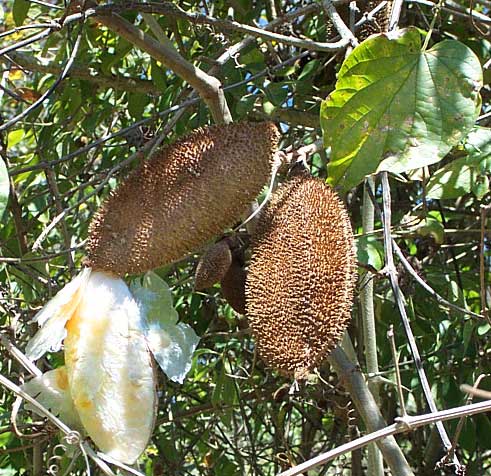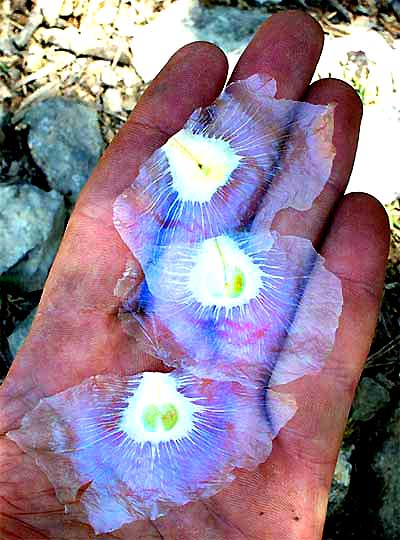Excerpts from Jim Conrad's
Naturalist Newsletter
from the March 24, 2007, issued from Sierra Gorda Biosphere Reserve, QUERÉTARO, MÉXICO
MONKEY-COMBS DROPPING BUTTERFLY-SEEDS
A common woody vine climbing into trees all along the road around the reservoir these days is producing a crop of eye-catching fruits. The fruits are brown, elliptic, about hand-size, flattish and -- most striking -- absolutely burry with short, blunt projections. These tubercles are responsible for the vine's name of Monkey-comb, PITHECOCTENIUM CRUCIGERUM. It's a member of the Bignonia Family, the family to which the northern Trumpet Creeper and Crossvine also belong. You can see two spiky, dangling monkey combs below:

In that picture the fruit on the left has split so that a mass of silvery, waferlike seeds has slipped from the spiny husk. Usually the seeds drop one or two at a time but a bird or something must have jarred this fruit, causing its contents to plop out all at once. Monkey-comb seeds with their cellophane-like, silvery wings lying on the ground are even more noticeable than the fruits hanging on their vines. Below, you can see three seeds in the palm of my hand.

Actually, what you see there is six seeds. The bottom item shows how each butterfly-like thing consists of two seeds with their wings grown together. Of course the wings help the seeds disperse on breezes.
A Spanish name for the vine is Palomitas, which means "Little Doves," and I suppose that the silvery seeds fluttering to the ground could be little doves landing. I think in this area the more common name is Mariposa, meaning butterfly. Back in the Yucatan it has a good Maya name, X-ne-tolok.
The English name Monkey-comb is based on its genus name, Pithecoctenium. In that word you might recognize "pitheco," which also appears in Australopithecus, the name of a group of extinct hominids closely related to humans. Australopithecus means "southern ape." Both "pitheco-" and "pithecus" derive from the Greek "pithekos," for ape. "Ctenium" comes from the Greek "ctenidum," for "comb." Monkey-comb.
Monkey-comb also is a far-ranging species, distributed from Mexico to Brazil.
In Mexico, at least traditionally, there's a pretty use of the butterfly-like seeds as a headache remedy. Just apply a seed to your forehead and the headache is supposed to go away. I bet that the usage is based on the subliminal notion that anything as transparent, light and ethereal as these seeds can't but help a dull, dark, throbbing headache.